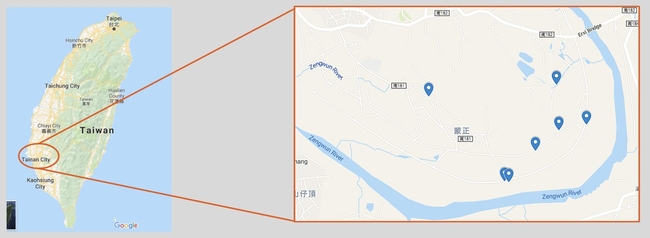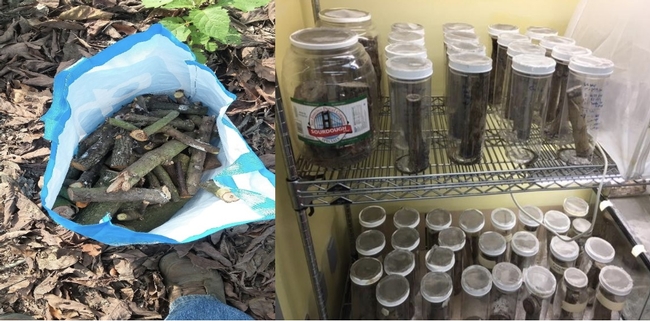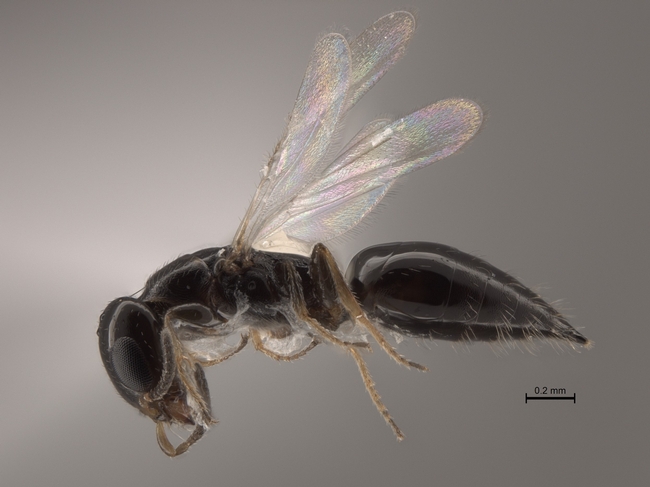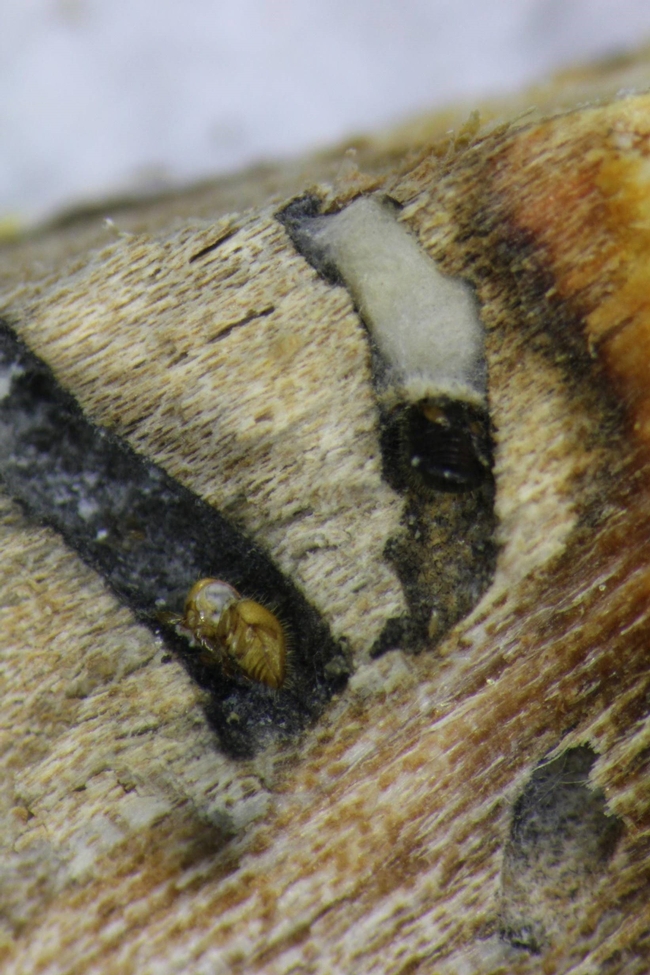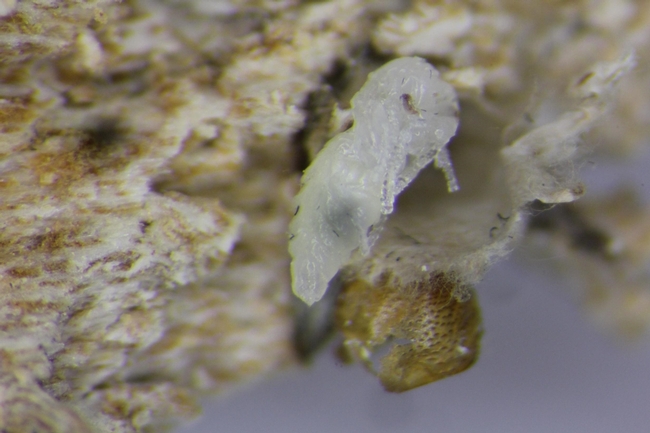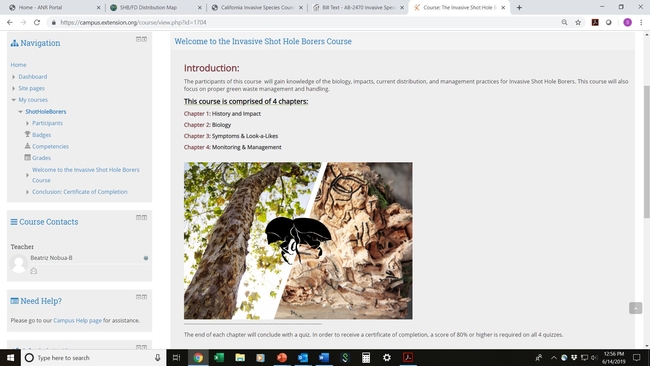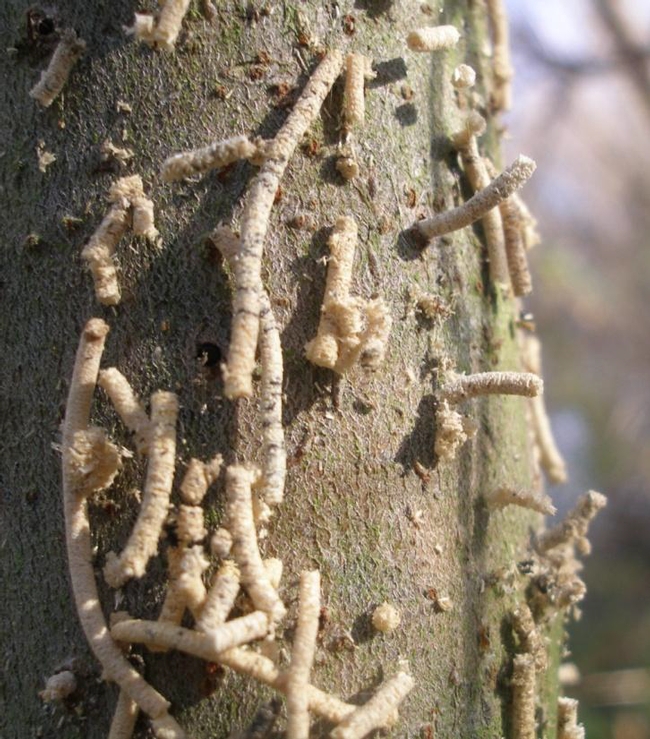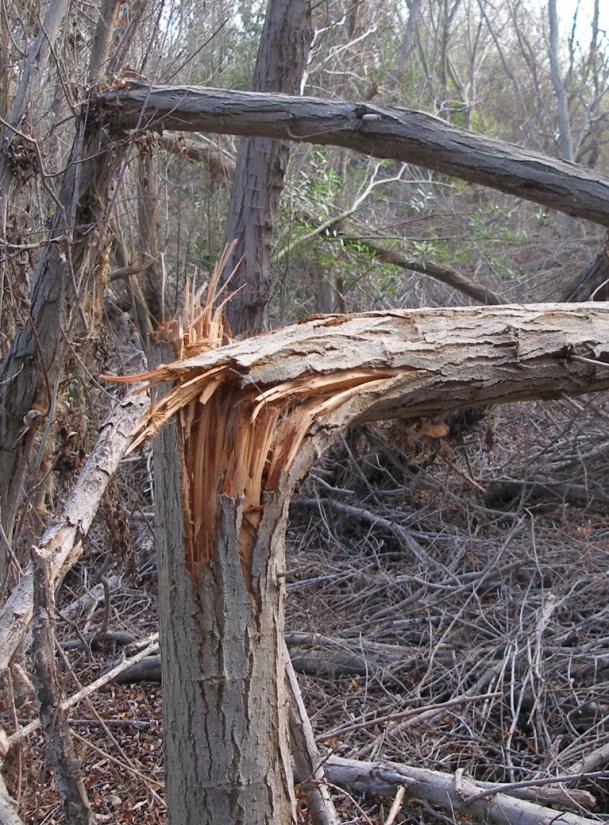
Posts Tagged: KSHB
Alcohol Loving Ambrosia Beetles
Ambrosia beetles, which are a large group of several thousand species worldwide, belong to the bark beetles. All species are characterized by the ability to cultivate fungi. Invasive Shot Hole Borers that attack avocado and a range of native and landscape trees in California and the Laurel Wilt Disease that hammers avocado in Florida are ambrosia beetles. These beetles cultivate fungi in living trees and over time, the fungus is what kills the tree.
Beetles share the work of cultivating their fungal gardens: some clean the tunnel systems that are being eaten into the wood; others clear the dirt from the nest and clean their fellow workers -- always with the aim of optimizing the symbiosis of beetle and fungus.
It's been long known that alcohol is produced by weakened trees and that these trees are recognized and colonized by the beetles. Traps baited with alcohol are used to catch the insects when they fly. Alcohol is very attractive to the beetles in large part because the fungi they feed on performs best in an alcohol-rich environment. Alcohol is normally used as a preservative to impede other fungi, such as molds from growing, and this is the case for the fungi associated with these beetles. They prefer to grow in an environment where other fungi don't grow.
Here's an interesting article showing how this preference by disease-causing fungi allows them to thrive in a normally harsh environment. Maybe it can be exploited.
Christopher M. Ranger el al., "Symbiont selection via alcohol benefits fungus farming by ambrosia beetles," PNAS (2018). www.pnas.org/cgi/doi/10.1073/pnas.1716852115
Photo: Party Beetles
Credit: Gernot Kunz
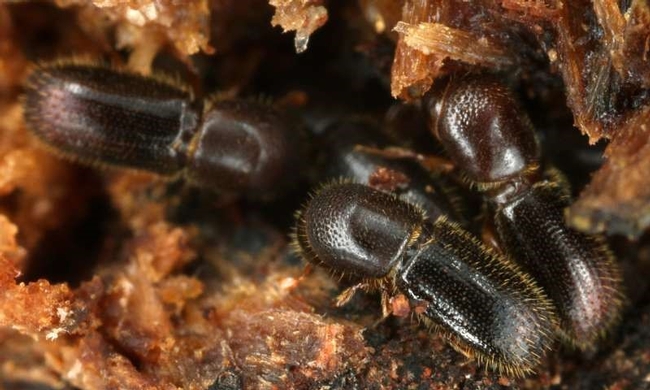
ambrosia beetles
Tea Shot Hole Borer - PSHB, KSHB, ISHB
A “boring” problem that's generating
big interest in southern California
By Deena Husein, UCR Entomology, Ph.D. Candidate, Stouthamer Lab, UC Riverside
It has been a little over a decade since the first sighting of the polyphagous shot hole borer (PSHB) in Los Angeles County, yet a reliable control method has not been established. Part of the setback was caused by the misidentification of the species due to the beetle having a similar appearance to a low-risk pest — the tea shot hole borer. Aside from Los Angeles County, the PSHB is now established in Ventura, Orange, Riverside, San Bernardino and Santa Barbara Counties. We should be very alarmed at the rate the beetle has spread in southern California! The PSHB bores tunnels, also called galleries, in the xylem of the plant host and compromises the water transportation system. Tissue damage on the plant host is not only caused by the boring action alone, but also by the symbiotic, yet pathogenic, fungi the beetles carry to inoculate the gallery walls and utilize as a food resource. Consequently, the fungal buildup obstructs more water from reaching the branches, which can lead to dieback symptoms and eventually the mortality of the tree. The underlying issue lies in the gradual increase of plant species susceptible to being attacked. Currently, there are over 300 plants, 60 of which the beetle can reproduce on, including several native oaks, maples, sycamores, and willows along with ornamental plants and major agricultural crops (avocado) (Eskalen et al. 2013). A study by McPherson et al. 2017 showed that 23.2 million trees (32.8%) of southern California's region are susceptible to attacks by the PSHB beetle. Should half become infested, the approximate cost of removing and replacing those trees will be $15.9 billion with an annual accruement of $616.9 million over the next 10 years. The damage and loss the beetles have already costed the state will only continue to rise without the establishment of an effective management program.
We understand that this pest is a major threat to the forestry and agricultural industry, but what efforts have been made to stop it? So far, conventional methods such as pesticides and mate disruption through pheromone traps have been rendered ineffective due to the beetle's cryptic lifestyle. The PSHB mates prior to leaving its natal gallery and is only outside for a brief period of time spent entirely on finding a suitable plant host. With that in mind, our laboratory has taken a different course of action that focuses entirely on biological control. Analyses of beetles sampled worldwide paved the path to a foreign exploration trip to Taiwan in the hopes of finding promising natural enemies of the PSBH. Since we are dealing with a wood boring beetle that remains hidden inside of its host, the best approach to encounter any natural enemy is by collecting beetle-infested plant material such as logs. The collection sites can be seen on the map below, all of which were in the district of Tainan City. Infested logs were shipped to the Insectary and Quarantine facility located at the University of California, Riverside (Figure 1A). From there, logs were individually placed in separate containers and monitored daily for anything that emerged (Figure 1B). After three trips and many logs later, we were able to identify three promising parasitoid wasps and two fungal-feeding nematodes associated with the PSHB.
The first parasitoid wasp we have encountered belongs in the family Bethylidae (Figure 2). A closely related species in the same genus has been documented to parasitize the coffee berry borer, another invasive pest with a similar lifestyle to the PSHB. While breaking apart some of the logs, we were able to find parasitized beetles with silk cocoons extending from their heads. Inside one of these cocoons was a bethylid pupa, which looks very promising (Figure 3). The second parasitoid is a braconid with an interesting method of attack. This novel species in the genus Sinuatophorus has prominent and large mandibles to 1) remove any excess material, such as frass and sawdust, at the entrance of the beetle gallery then 2) clasp the head of the beetle and eventually parasitize it. However, most taxonomic descriptions of wasps in this genus always cite Seitner and Notzel's publication from 1925, which mainly focuses on the development and lifecycle of another closely related wasp in a different genus. This poses as a challenge since our understanding of the lifecycle of this novel wasp is limited. Despite this setback, we were able to rear 4 generations by reintroducing every newly emerged wasp to multiple PSHB-infested castor bean logs.
The third parasitoid belongs to a very small, yet unique, group. Not only does this wasp attack beetles in their adult stage, but it also lays two eggs: one male and one female. Once fully developed, the female chews a hole from the inside of the abdomen and creates an exit path for herself and the male wasp. But the excitement doesn't stop there! While rearing beetles that emerged from the shipped logs, we were able to come across multiple nematodes. While most of them appeared harmless, some were categorized as fungal feeders. By introducing these fungal-feeding nematodes to beetle galleries, we could potentially use them as an indirect approach to mitigate the population of the beetles by attacking their food supply.
We have come pretty far in the past three years and are now able to narrow our efforts on these natural enemies. Though, as is the case with most biological control programs, there are many challenges and failures that will be faced. Our biggest hurdle to overcome is the cryptic lifestyle of the beetle. Once we introduce newly emerged wasps to beetle-infested logs, any control we have over the rearing process is taken away. Basically, this becomes a black box with no way of observing any parasitization occurring inside without breaking into the logs and jeopardize killing the insects by accident. We are currently trying to improve our rearing methods in the hopes of increasing our wasp colony size. Eventually with large numbers, we can move forward with non-target testing and come to a decision on whether or not we can utilize these natural enemies as a biological control agents to suppress the PSHB population.
Map: collection sites of PSHB beetle-infested avocado logs from Tainan City, Taiwan.
Figure 1A (left): Bag with beetle-infested avocado logs from Taiwan. Figure 1B (right): Temperature-controlled room with logs separated in plastic containers in the Insectary and Quarantine facility at UCR.
Figure 2:Image taken of Bethylid adult that emerged from beetle-infested avocado logs collected from Taiwan. Credit: Iris Chien
Figure 3 (top): Parasitized PSHB found with a silk cocoon extended from the head of the beetle. Bottom:A cocoon was dissected, adjacent from the intact cocoon, with a visible bethylid pupa.
Read and see more at:
http://ceventura.ucanr.edu/newsletters/Topics_in_Subtropics80946.pdf
Literature Cited:
Eskalen, A., Stouthamer, R., Lynch, S. C., Rugman-Jones, P. F., Twizeyimana, M.,
Gonzalez, A., and Thibault, T. (2013). Host range of Fusarium dieback and its
ambrosia beetle (Coleoptera: Scolytinae) vector in Southern California. Plant Dis,
97(7), 938–951.
McPherson, G., Xiao, Q., Van Doorn, N. S., De Goede, L., Bjorkman, J., Hollander, A., Boynton, R. M., Quinn, J. F., and Thorne, J. H. (2017) The structure, function and value of urban forests in California communities.Urban Forestry & Urban Gardening 28: 43-53.
Seitner, M. and Notzl, P. (1925). Pityophthorus Henscheli Seitner und sein Parasit
Cosrnophorus Henscheli Ruschka.
ISHB Update and an Online Training Course
Update on invasive shot hole borers: Online training now available
By Sabrina Drill, Natural Resources Advisor, UCCE Ventura
Invasive shot hole borers (ISHB) are a pest and disease complex potentially affecting over 200 tree species, but posing a strong risk to box elders, sycamores, and other riparian and urban trees, as well as being a nuisance pest for avocado. The beetles have also been shown to attack a wide variety of common and less common ornamental species. For a complete host list, visit https://ucanr.edu/sites/pshb/overview/SHB_Reproductive_Hosts/. The tiny beetles burrow into the trunks and branches of trees and create galleries where they cultivate a fungus that utilizes the trees own circulatory system, harming and in some cases killing the tree. We know the beetle can reproduce in over 60 species of trees, and they have devasted natural riparian areas, though we are beginning to see recovery of some infestations. Currently, the most effective management method is to remove infested wood, sometimes entire trees, and chip what is removed to minus 1”.
ISHB are now firmly established in Ventura County, with finds throughout the Santa Clara River Valley in traps from South Mountain to Toland Park in Santa Paula, and several infested box elder and sycamores in Meiner's Oaks and Ojai. It appears not to have crossed into the county in the south, but there are still active infestations in western Los Angeles County.
Personnel from UC ANR, CDFA, the Ventura County Agricultural Commissioner, and the US Forest Service have taken lead roles in developing a statewide ISHB action plan for the California Invasive Species Advisory Committee, with an initial investment of $5 million to work on controlling the pest. Plan elements include research in the ecology and control of the pest, including work to develop biocontrol; an early detection and surveillance program; addressing green waste and other pathways of spread, and outreach and education.
In terms of education and outreach, an area where Cooperative Extension in Ventura, LA, Orange, and San Diego counties have led, we're excited to announce the release of a new on-line training course. Available through our website, https://ucanr.edu/sites/pshb/, the course is actually served by the eXtension on-line learning platform (and users will need to create a free account). The course consists of 4 chapters including history and impacts, biology, symptoms and look-alike pests, and monitoring and management. While it can't fully replace a field training, it can be a good way to familiarize new staff to the issues.
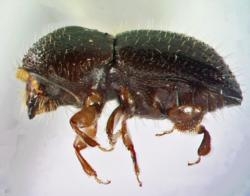
shot hole borer
Shot Hole Borer Update
Impacts of the invasive shot hole borer (Euwallacea kuroshio) are linked to sewage pollution in southern California: the Enriched Tree Hypothesis
By: John M. Bolandand Deborah L. Woodward
https://peerj.com/articles/6812.pdf
The Kuroshio Shot Hole Borer (KSHB, Euwallacea kuroshio) and the Polyphagous Shot Hole Borer (E. whitfordiodendrus; Coleoptera: Curculionidae: Scolytinae) have recently invaded southern California and are attacking live trees in commercial agriculture groves, urban parks and native riparian forests. Among native forests the worst impacts observed to date have been in the Tijuana River Valley in south San Diego County, where approximately 30% of the native willows (Salix spp.), or120,000 trees, have died as a result of a KSHB infestation. This paper examines wood densities, wood moisture contents, KSHB infestation rates, and KSHB-induced mortality rates in two willow species (Salix lasiolepis and S. gooddingii) at sites near and far from sewage input. Comparisons were made on two spatial scales: broadly among sites within San Diego County; and locally among sites within the Tijuana River Valley. The results showed that, on average, willow trees growing closest to sewage pollution had significantly lower wood density, higher wood moisture content, higher KSHB infestation rates, and higher KSHB-induced willow mortality rates than those growing farther away. We present the Enriched Tree Hypothesis to explain the link between sewage pollution and KSHB impacts; it is as follows: (A) Riparian trees subject to nutrient enrichment from frequent sewage pollution grow quickly, and their fast growth results in wood of low density and high moisture content. If attacked by the KSHB, the trunks and branches of these nutrient-enriched trees provide an environment conducive to the fast growth of the symbiotic fungi upon which the KSHB feeds. With an abundant food supply, the KSHB population increases rapidly and the trees are heavily damaged by thousands of KSHB galleries in their trunks and branches. (B) Riparian trees not subject to frequent sewage pollution grow more slowly and have denser, drier wood. Conditions in their trunks and branches are not conducive to the fast growth of the KSHB's symbiotic fungi. The KSHB generally ignores, or has low abundances in, these slow-growing trees. This new hypothesis explains current patterns of KSHB impact in San Diego County and focuses attention on the important roles of the environment and preexisting conditions of trees in determining the extent of KSHB impact .It highlights the Tijuana River Valley as an unusual site due to high sewage inputs and predicts that the high KSHB-induced willow mortality seen there should not occur in other natural riparian habitats in southern California. Most importantly, by identifying sewage pollution (or nutrient enrichment) as a major risk factor for KSHB impacts, the hypothesis ratchets down the KSHB-threat level for most riparian sites in southern California and directs attention to other nutrient-enriched sites as those most at risk.
The complete article can be found at:
https://peerj.com/articles/6812.pdf
Two newly published scientific journal articles that address SHB species delineation are:
- Gomez et al. Species Delineation Within the Euwallacea fornicatus. in Insect Systematics and Diversity, (2018) 2(6): 2; 1–11. (Attached) Richard Stouthamer and Paul Rugman-Jones, both with UC Riverside, are two of the co-authors
- Hulcr, J & Landers, J. January 7, 2019. So Many Shot Hole Borers: New research charts four nearly identical species. in Entomology Today. https://entomologytoday.org/2019/01/07/so-many-shot-hole-borers-new-research-charts-four-nearly-identical-species/
Examples of ambrosia beetle impact on willows. (A top) KSHB excavate galleries within a trunk and push the sawdust tailings out of their entrance holes. (B lower) Trees can be undermined by many galleries and snap in high winds. [These pictures show the extremes – infested trunks do not always look like A, and infested trunks do not always break, like B. Images: John Boland]
Controlling Shot Hole Borer
A recent study by Joey Mayorquin and team shows a promising chemical response in sycamore trees infected with Fusarium Dieback. This holds hope for the pest/disease complex in avocado, as well.
Chemical Management of Invasive Shot Hole Borer and Fusarium Dieback in California Sycamore (Platanus racemosa) in Southern California
Fusarium dieback (FD) is a new vascular disease of hardwood trees caused by Fusariumspp. and other associated fungal species which are vectored by two recently introduced and highly invasive species of ambrosia beetle (Euwallacea spp. nr. fornicatus). One of these ambrosia beetles is known as the polyphagous shot hole borer (PSHB) and the other as the Kuroshio shot hole borer (KSHB). Together with the fungi that they vector, this pest–disease complex is known as the shot hole borer–Fusarium dieback (SHB-FD) complex. Mitigation of this pest–disease complex currently relies on tree removal; however, this practice is expensive and impractical given the wide host range and rapid advancement of the beetles throughout hardwoods in southern California. This study reports on the assessment of various pesticides for use in the management of SHB-FD. In vitro screening of 13 fungicides revealed that pyraclostrobin, trifloxystrobin, and azoxystrobin generally have lower effective concentration that reduces 50% of mycelial growth (EC50) values across all fungal symbionts of PSHB and KSHB; metconazole was found to have lower EC50 values for Fusarium spp. and Paracremonium pembeum. Triadimefon and fluxapyroxad were not capable of inhibiting any fungal symbiont at the concentrations tested. A 1-year field study showed that two insecticides, emamectin benzoate alone and in combination with propiconazole, and bifenthrin, could significantly reduce SHB attacks. Two injected fungicides (tebuconazole and a combination of carbendazim and debacarb) and one spray fungicide (metconazole) could also significantly reduce SHB attacks. Bioassays designed to assess fungicide retention 1 year postapplication revealed that six of the seven fungicides exhibited some level of inhibition in vitro and all thiabendazole-treated trees sampled exhibiting inhibition. This study has identified several pesticides which can be implemented as part of an integrated pest management strategy to reduce SHB infestation in low to moderately infested landscape California sycamore trees and potentially other landscape trees currently affected by SHB-FD.
https://apsjournals.apsnet.org/doi/abs/10.1094/PDIS-10-17-1569-RE
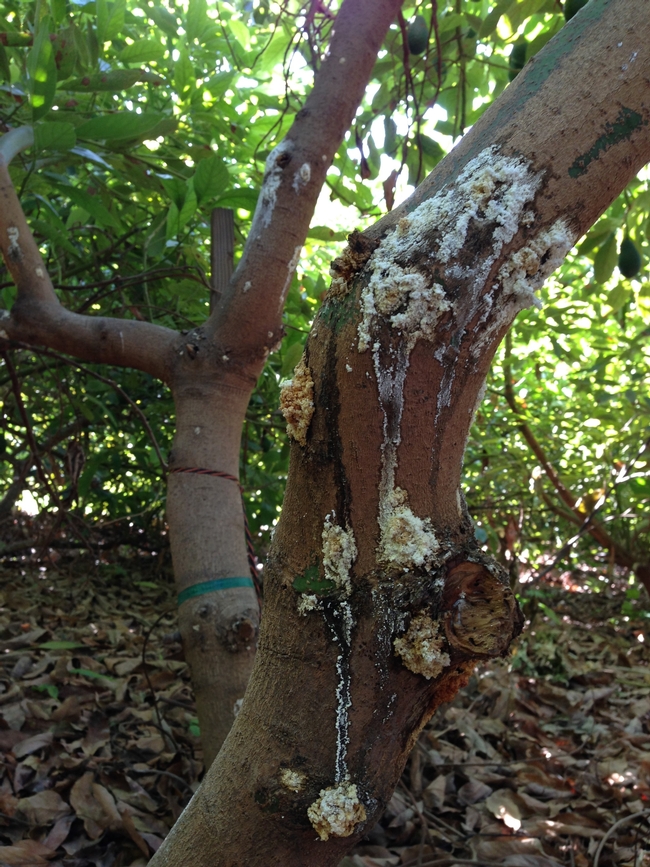
shothole 1

